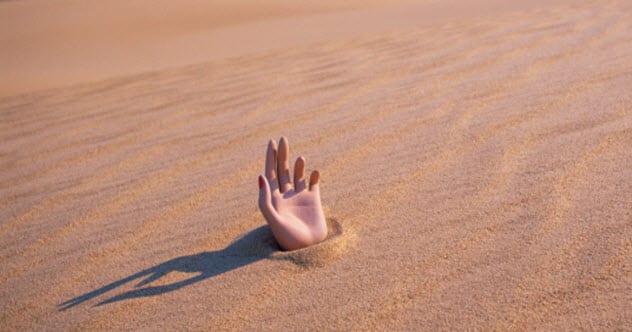
It’s always a good idea to take walks on the beach or the wilderness with a companion. The old cliché that there is safety in numbers is true here as well. That enables water to flow down and loosen the sand, so you can slip out. Wiggle your legs around, creating a space between them and the quicksand. A pit of quicksand is like a swimming pool and you will only sink if you stand, but you’ll float if you spread out. If you’re waist deep, lean on your back and don’t panic. So as your weekly riskologist columnist, let me warn that if you ever find yourself knee deep in quicksand, the first thing you should do is slowly sit down. Some of those who did die were done in by related events, like drowning when the tide came in, hypothermia or dehydration. In my quest for the truth I was able to ascertain that only a handful of people worldwide have died from quicksand in the past decade. Quicksand does pose a threat, just not as significant as we once were lead to believe. But its buoyancy makes it impossible to be completely submerged. The truth is that the more people struggle, the deeper they sink into the soupy mixture. Quicksand is not a bottomless pit and it definitely doesn’t suck and swallow up unsuspecting victims where they are never to be found again. Real quicksand is certainly hard to get out of, but it doesn’t suck people under as portrayed by Hollywood. The fact is if you were to stumble into quicksand you wouldn’t sink in - at least not completely. The undisturbed sand often is or appears to be solid until some sudden increase in pressure causes it to liquefy. It can be formed when sand, silt, clay or other grainy soil is saturated by water flowing from below ground, such as from an underground spring, with enough pressure to separate and suspend the grains. Quicksand is loose, water-logged soil that yields easily to weight or pressure. In general, quicksand can appear when two conditions are present: sand and a source of rising water. The truth is quicksand is very real and can be found in many parts of the U.S., including New Jersey, the coast of North Carolina, and many areas in the Southeast, particularly Florida. According to the golfer stepped into the quicksand while he was trying to retrieve his golf ball, and when they eventually found him, he was in up to his chest.


I did discover an insurance claim was recently filed by a golfer after he had to be rescued from quicksand on a golf course in New Milford, CT. I imagine there was quicksand located there at some point. In my research I was unable to locate any documented “quicksand pits” in my home state of Kentucky, but I did discover a community called Quicksand, Kentucky, first settled in 1791 and is located in the rural parts of Eastern Kentucky. If it was a true risk, I would also suspect the insurance industry would have capitalized at the height of the “threat” by offering some type of policy, but I found no record of such coverage. With my risk management and safety training, I imagine that if quicksand was a real threat, OSHA would have addressed it somewhere within their standards.

So the question is was it ever really a threat? Seriously, when was the last time you witnessed somebody sinking into quicksand?Īfter an engaging discussion on the subject on Facebook with my former high school teammate and good friend Paul Vines, I felt obligated to research the true risks of quicksand and provide my weekly readers with safety tips to avoid and/or survive it. As the shock value of quicksand wore off, it’s pretty much vanished from pop culture. The general rule of thumb in those days was if you saw a hat on the ground, you didn’t walk over to pick it up.įast forward to today and quicksand has all but evaporated from American entertainment, rejected even by the genre directors who once found it indispensable to plot development. Nearly every western had an episode where somebody would find themselves sinking inside one of these soupy, oatmeal-looking liquid pools of death. The threat back in those days appeared very real, as it was a staple of about every adventure series, horror flicks and B-grade science fiction movies. Some of us even tried to train our dogs to go for help, like Lassie would do every time Timmy found himself in a dangerous situation. Many of us practiced rescue missions with our friends and siblings as we developed elaborate emergency quicksand evacuation plans to ensure we were all home once the street lights came on, which was our universal curfew. Indiana Jones was one of many Hollywood characters to battle quicksand (Photo Provided)


 0 kommentar(er)
0 kommentar(er)
